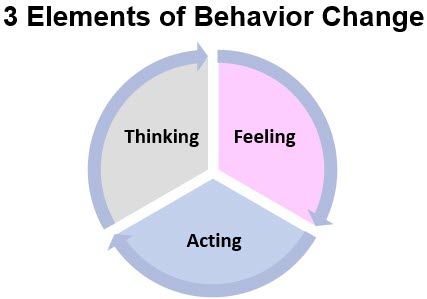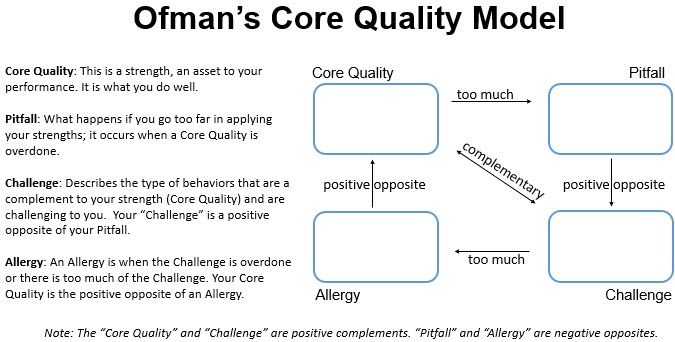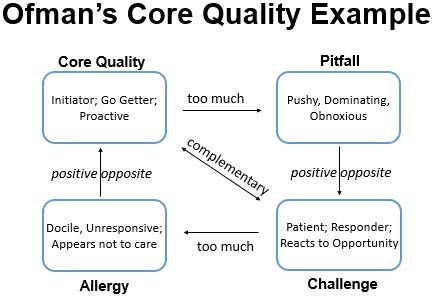Developing Leaders: A Perspective Based on Ofman's Core Quality Model
We've worked with a lot of people on their professional development. Most of us could use some kind of growth that improves our effectiveness. The questions are:
- What needs to change?
- How can I think about that change?
Any kind of change in behavior involves three aspects of our being:
- Thinking
- Feeling
- Acting

The premise is that unless we pay attention to and align all three, there is little chance that the change we desire or envision will be significant or permanent.
This article is primarily about the thinking aspect of development or how we mentally frame what we're planning to change or achieve. At a more concrete level, let's consider the magnitude of the change or improvement we're envisioning.
The most frequent way of visualizing strengths and weaknesses is with the classic continuum:

Using this image creates the impression that the respective elements are at opposite ends of the continuum and are far apart.
In my personal and professional experience, there are any number of characteristics that might be considered strengths which can easily morph into something that is significantly less effective. I have written about the "Omega Syndrome" where the Greek symbol replaces the continuum and the strength/weakness relationship is portrayed more realistically in regard to how easily a strength can morph into something else.
So how we frame something, or think about it, can significantly impact how we address it. Daniel Ofman's Core Quality Model provided a significantly different way to think about strengths and weaknesses . . . and even gave me a new label for the latter.
Daniel Ofman's Core Quality Model
Some years ago a colleague, Patrick Merlevede the president of jobEQ, introduced me to Daniel Ofman's Core Quality Model.
Ofman's framework provides a way to think about how one's strengths, if overdone, could turn into Pitfalls. Here is a graphic of the model along with explanations of the components.

A Core Quality Example
Take, for example, a Core Quality (strength) of being "proactive". Being proactive may be important in entrepreneurs, business developers, and similar roles. Let's say that we measure Proactivity on a scale of "0" to "100" and that a particular individual has a rating of "95" . . . a real "go-getter".
Ofman introduces the notion that if proactivity at a level of 70-100 is an asset in certain roles, the scale doesn't stop there. The scale could go to 200.
If that's the case and if there are times in which the individual's proactivity (strength) rating goes to "170", the resulting behavior is most likely different than the behavior we saw or experienced at a level of "95" and is quite likely less effective than at the 95 level.
The resulting behavior at a proactivity rating of "170" is what Ofman refers to as a Pitfall. Notice that it is not labeled a "weakness".
What does the Pitfall for a strength of proactivity look like? The individual might be described as "pushy", "overbearing", "dominant", or "obnoxious".
One can argue that there are times when Pitfall behavior is appropriate (perhaps in responding to a bully), but far more often, it is not.
How Did We Get to a Pitfall?
When analyzing one's evolution of a strength into a pitfall, there are two questions:
- What conditions or stimuli cause a strength at the 95 level to rise to a level of 170 and trigger the pitfall? This is the analysis of "cause".
- How do I behave in the pitfall stage and what are the effects of that behavior? This is the analysis of "effect".
The answers to these two questions are crucial to your plan for improvement or for avoiding derailment, but that's not where the value of Ofman's framework ends.
Your Challenge and Allergy
What Ofman calls the "positive opposite" of your pitfall is your Challenge. Your Challenge is a complement to your Core Quality. It is the condition or behavior that balances and provides an alternative to your strength.
When you possess both a Core Quality and its corresponding Challenge, you have the tools to display agility; that is, the ability to make shifts in perspective and behavior when circumstances arise or change that would otherwise result in your strength becoming a Pitfall.
But your Challenge can be overdone when it is a strength. When that happens, it results in what Ofman labels an Allergy.
While an Allergy is the negative opposite of your Pitfall, your Core Quality is the positive opposite of your Allergy.
When you have a given strength, you are likely "allergic" to behavior in the Allergy category and will respond negatively to it and can even allow your reaction to the Allergy to trigger your Pitfall behavior.
Here's an Ofman Diagram with some entries for the example above.

Conclusion
Becoming more effective as leaders is key to long-term success. How we frame or think about being more effective influences to a large extent how we deal with it.
In this article, we used the trifecta of thinking-feeling-acting to highlight the essential elements of behavior change that must align if change is to be permanent. Then, we cited the work of Daniel Ofman to provide a vehicle for how we define and understand the strengths on which we build and the challenges we want to change. The Core Quality Model helps us frame how we can morph from a position or condition of strength to one which results our being less effective than we want or need to be.
You might want to consider taking a look at Daniel Ofman's Core Quality Model and to see if it provides a means to both understand your behavior as a manager and leader as well as provides some insight into cause(s), effect(s), and alternatives.
Where each of us is as a leader and where we might want to get to is different. We can, however, use some common tools for understanding our personal landscape and for building a plan to improve it.
If you have questions or feedback, email it or them to: carl@harshman.com.
Thanks for visiting.